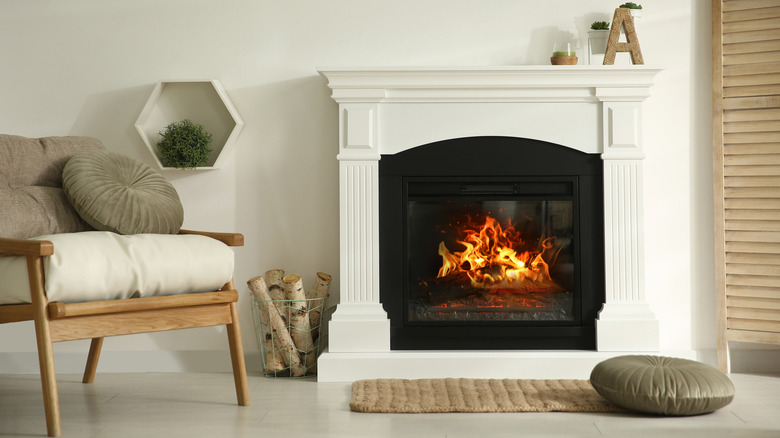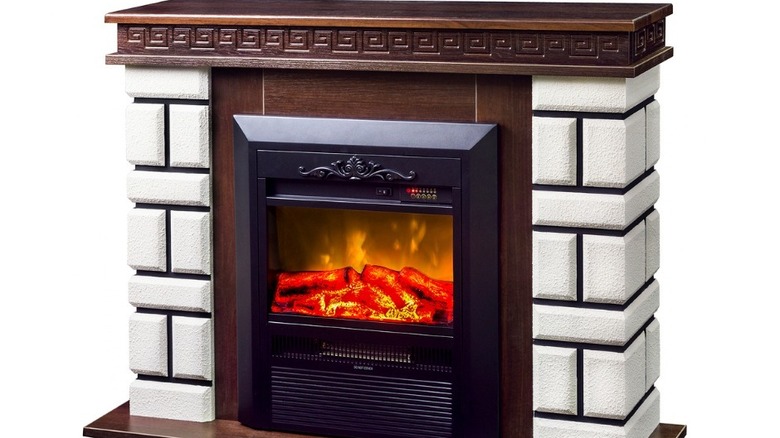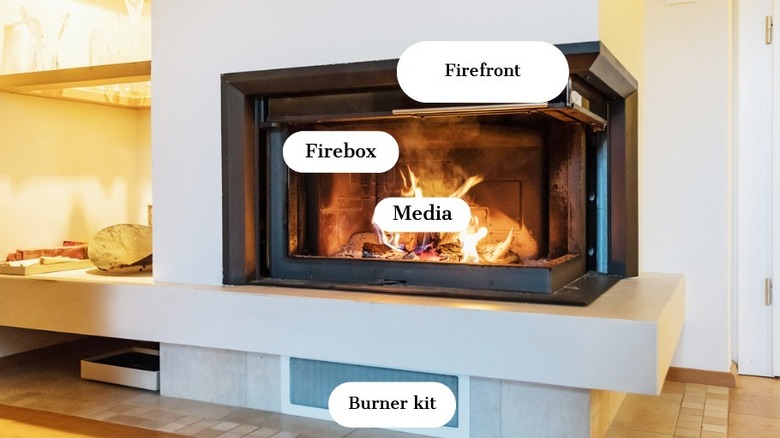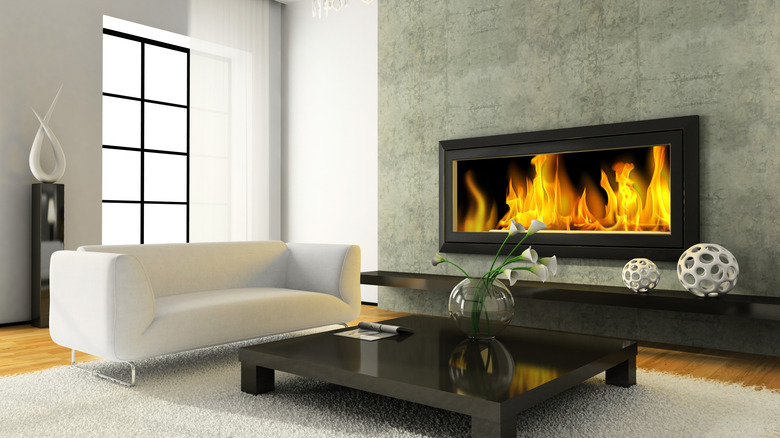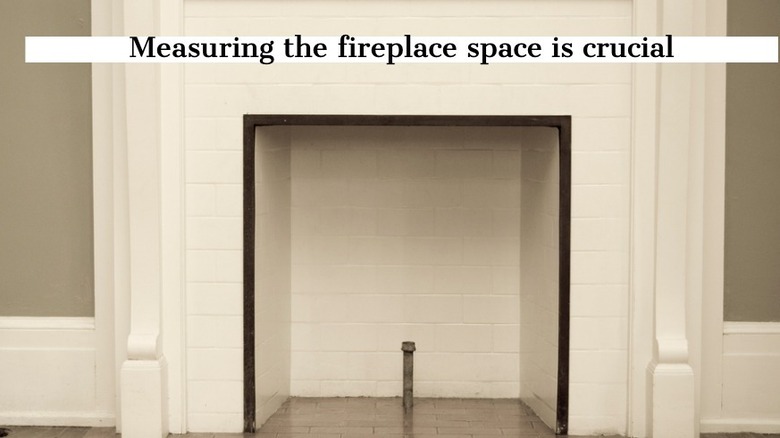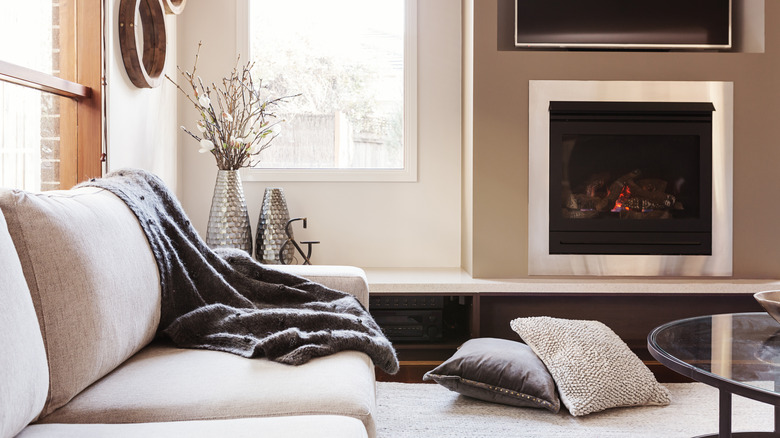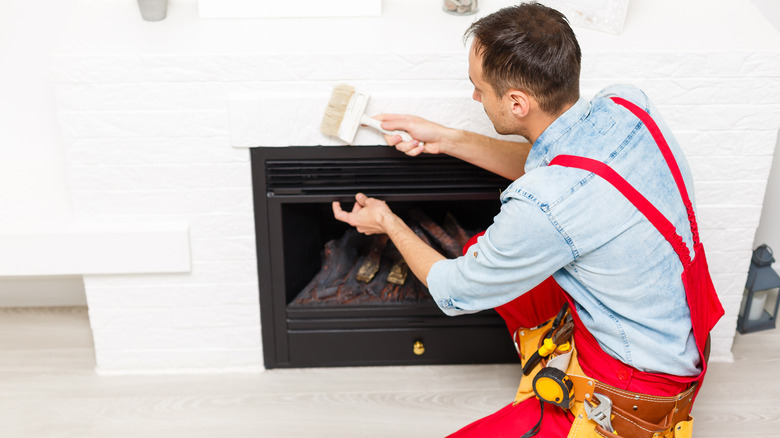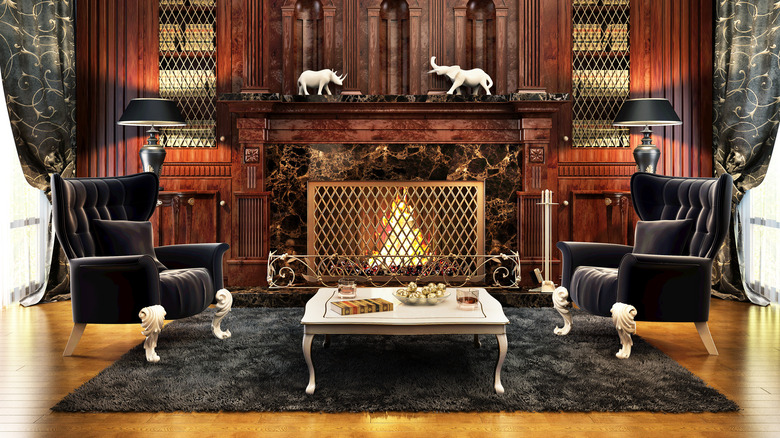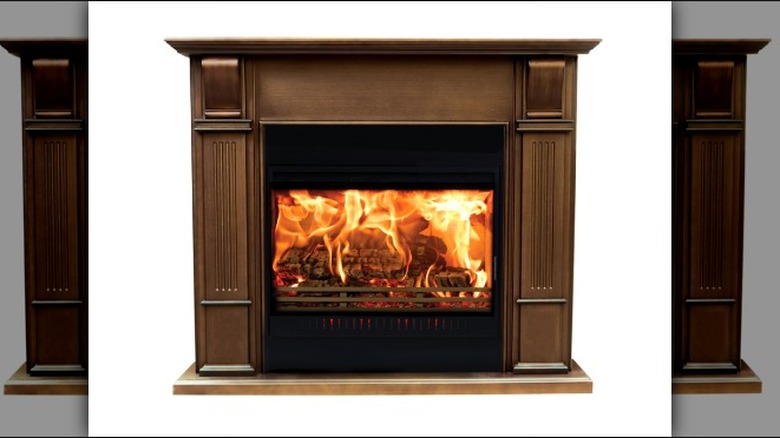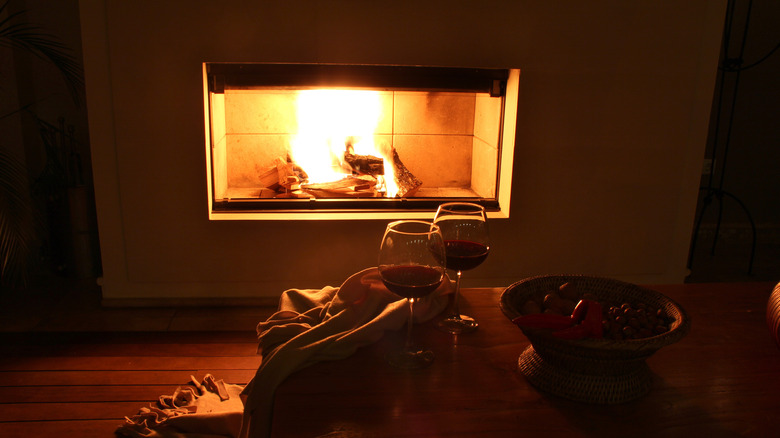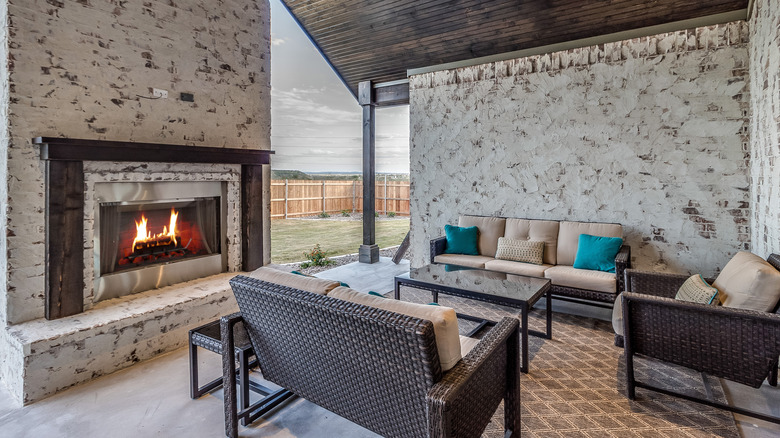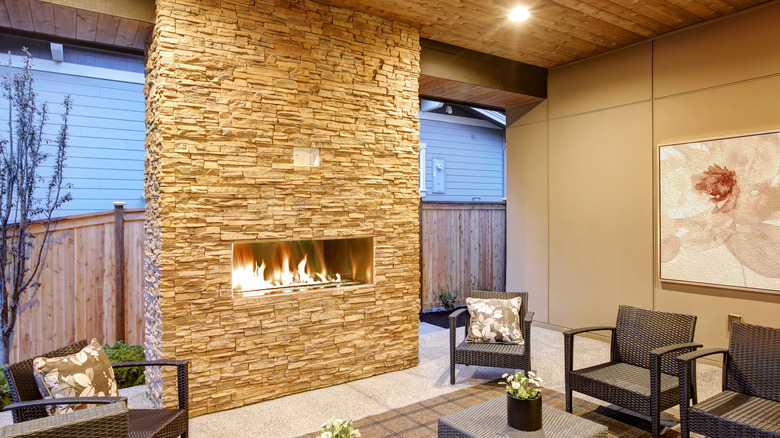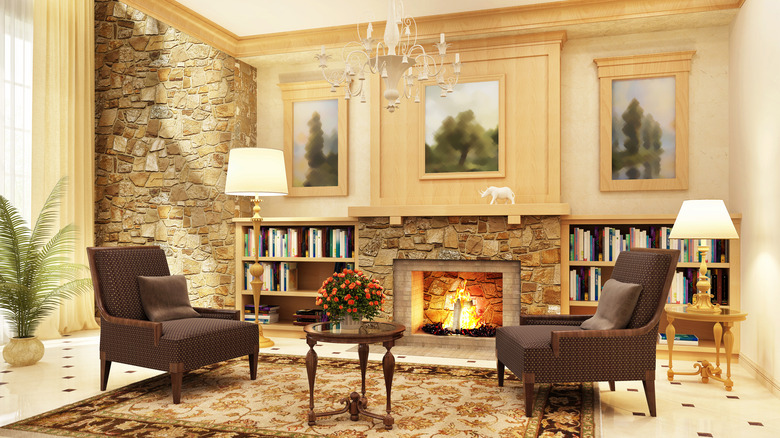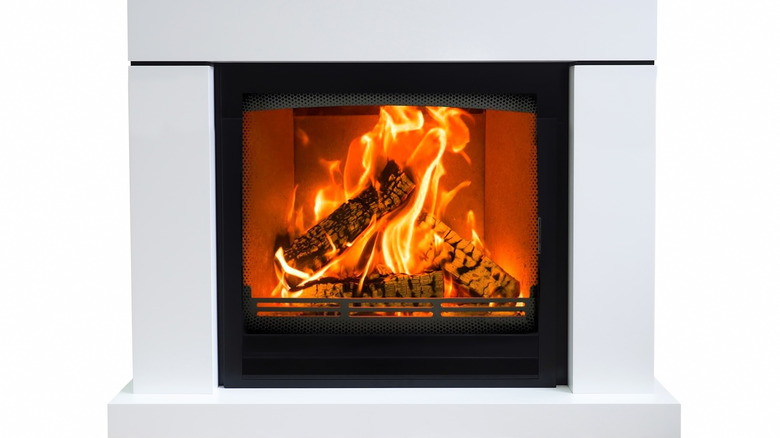What To Know Before You Buy A Ventless Gas Fireplace
We may receive a commission on purchases made from links.
If you live in Alaska or North Dakota, or outside the states in any of the most freezing countries of the world (such as Canada and Russia), your house is never a home without a fully functional heating system, e.g. a fireplace. In 2021 alone, a winter storm in Texas was reported to have frozen 246 people to death and caused billions in damage (via NPR).
Cold weather is a global phenomenon, and has made heating systems a must-have in homes as well as in some workplaces. And beyond just keeping warm, The Outdoor GreatRoom Company writes, sitting next to a fireplace has some surprising health benefits such as lowering blood pressure. Additionally, Northeasthern Chimney LLC shares that 46% of home buyers are willing to pay more for a home with fireplace. This means that you can bump up the resale value of your home by simply installing a fireplace –– outdoor, indoor, or both.
And, as traditional chimneys are fast becoming a relic (via MarketWatch), high-end, smoke-free, integrated heating systems such as the ventless gas fireplace are the new trend. So, if you're considering installing one of those, this eye-opening post will make you better-informed and equip you with what to know before buying a ventless gas fireplace. Let's get started.
What is a ventless gas fireplace?
A ventless gas fireplace is, of course, a fireplace without a vent. It is powered by pure gas to produce up to 40,000 btu heat output (via White Mountain Hearth). No venting construction is needed, therefore no heat is lost each time you warm yourself by the fire, according to Regency. Additionally, vent-free systems are meticulously engineered to enhance energy efficiency at a low cost and to overcome the drawbacks of traditional vented fireplaces, e.g. the emission of hazardous fumes and creosote build-up, High's Chimney Service writes. The gas hearth is also preferred for its looks and the fact that it's often commercially rated as 99% carbon monoxide emission-free (the deadly, odorless gas that kills nearly 500 U.S. residents every year), per the CDC. However, it has been noted that this commercial claim is not only untrue, but contradicts simple logic as well.
Think about it: Without exhaust vents, where are all those emissions going? Well, no other place but inside your home. As explained by Full Service Chimney, though this fireplace uses pure gas which is potentially non-toxic, the burning process produces nitrogen dioxide, water vapor, carbon monoxide, formaldehyde, and carbon dioxide. When all of these by-products mix with the dust/dirt content of the air, it makes the air we breathe less pleasant. To that end, Design Air says, no-vent warmers should be paired with plentiful carbon monoxide detectors, air purifiers, and air filters. Here at House Digest, we also recommend adding some indoor plants that are scientifically proven to purify air and thrive in hot conditions –– these plants will also serve as décor.
Note: Ventless fireplaces are banned in some states so you better do your homework before opting for one.
What are the parts of a ventless gas fireplace?
A ventless gas fireplace is a complete burner kit that consists of a burner tray, ignition system, and control system. As explained by Fireplace Universe, the ignition system uses a pilot to start the fire, which comes out of holes in the burner and is adjusted via the control system. Mind you, burner kits vary greatly, as noted by My Gas Fireplace Repair. Another feature is the fireplace media, and without one, sitting next to the fireplace would be like warming yourself by a kitchen range. According to Stove Parts Unlimited, the fireplace media –– which can be log, rock, coal, glowing ember, or fire glass –– works together with the burner to produce warmth and beauty in a safe manner. Also, for ventless gas systems to work, HomeSteady explains, a gas line is needed to shuttle gas from a compartment to the burner kit through a valve. Technically, this valve opens once you activate the ignition system, and it allows gas to flow into the burner at a level set by the control system.
The next feature is a firebox. Fireside Hearth & Home describes a firebox as an airtight compartment with a glass door. It encloses the burning fireplace media, radiates the heat generated from there, and prevents smoke from escaping into your room. Around this box is the convection space, a dead space that enables proper air circulation. Also, most vent-free systems feature an ODS (oxygen depletion sensor). ODS systems help to detect room oxygen level in order to reduce health concerns. Finally, most modern vent-free hearths come with a remote control for easy accessibility, and a firefront, which is a removable decorative feature that aesthetically frames all internal components.
Two other types of ventless fireplace
So, your first option is a gel-powered ventless fireplace which runs on gelled isopropyl alcohol fuel; it uses a 13-ounce canister of gel in 2.5 hours while producing up to 9,000 btu of heat (via House Logic.) Additionally, a complete 12-pack of the popular Real Flame Fuel Gel that goes for $75 will keep your hearth burning for 36 hours. However, as seen on Find Any Answer, this duration may change depending on location –– for instance, a windy environment burns gel faster. As described by Ventless Fireplace Pros, gel-powered systems produce a synthetic flame that is smoke-free and doesn't give off any by-products –– toxic or not. Homeowners may prefer these fireplaces to other options because of their design simplicity, environmentally-friendly operation, easy installation, and unique beauty. To get you started, Ice-Energy reviews 10 of the industry best ventless gel systems.
Option number two is an electricity-powered ventless fireplace. These systems are the new big thing in modern architecture right now. In fact, as sighted on Dengarden, homeowners who are late to the party are already converting their wood and gas systems to electric heating. Ventless Fireplace Pros says electric inserts are mostly adopted to generate about 4,500 btu of heat in small rooms and add ornamental characteristics. They are low-maintenance, can be installed anywhere, and can heat up or cool down almost instantly in response to control. According to ElectriFlames, there are about six categories of electric fireplaces, each of them featuring LED light-created flames that look like the real thing. All electric inserts except the log inserts can be mounted under a TV, but they are all relatively budget-friendly, mostly going for $89 to $600 per unit.
What size ventless gas fireplace is best for me?
Size does matter when it comes to choosing and installing a heating appliance. Why? Well, installing a log set bigger than your fireplace is likely to cause control problems, poor draft, or overheating. Likewise, fitting an overly small heating system in a wide fireplace space will make the room look odd. To avoid both scenarios, eFireplaceStore says you need to measure the fireplace, add extra space for the log set's control systems, and consider aesthetics. To take the fireplace measurements, Fireplace Doors Online writes, measure both the width of the front opening and that of the inner rear. You should also measure the height of front opening and depth of fireplace from front to rear. Once taken, these measurements should be recorded in your mobile phone memo or a notebook so that you don't forget them.
Now, let's add an extra space for control systems and aesthetics concerns. In this case, we have two options. Option number one: Type the measurements taken so far into the free online gas log size calculator available on Blazzing Fire to find the gas log size you need for your fireplace. Option number two: Go for a gas log set that is 2 to 6 inches smaller in front width than the fireplace width, shares an equal width with the fireplace's rear, and is 2 inches less deep and 2 inches shorter compared to the fireplace. Alternatively, you can use Fireplace Doors Online's gas log size graph for standard sizing.
Vented gas fireplace vs. ventless gas fireplace
For those of you who are still on the fence, this section will give you a broader overview of the other guy (a vented gas fireplace) while revealing to you some facts about ventless gas inserts.
If you're more driven by aesthetics than you are by the need to heat your home with a sustainable source, you should probably be opting for a gas fireplace that has a venting chimney. According to Total Home Supply, vented gas inserts are engineered to mimic traditional wood-burning fireplaces. They give out a fuller, more natural-looking flames in a healthier and safer way. We say "healthier" as long as you always keep the chimney damper open when in use to avoid the build-up of combustion by-products in your home. Though it's healthy and necessary to keep the damper open, the implication of it is that a fair share of the heat is lost through the chimney, therefore you may not always get all the warmth you need.
So, on to the general facts about ventless gas fireplaces. First, ventless systems convert 100% of the gas used into heat. They are almost always rated 100% efficient because no-vent means no heat escapes. However, The Flame Company explains, ventless systems are space-demanding and you'll want to always keep your furniture and clothes far away from their exposed fireboxes. Also, the ODS (oxygen depletion system) built into them as previously mentioned is not always sufficient, so you may need to invest in air purifiers to prevent the build-up of water vapor and odor, Woodland Direct writes.
How long does a ventless gas fireplace last?
Understanding how many years your investment in a ventless gas fireplace will last is just as important as acquiring it. This knowledge is needed to shape your expectations, especially about future replacements. Generally, the lifespan of all fireplaces is determined by the material they are made of, the design (vented or ventless), the frequency of operation, and the level of maintenance they receive. Let's discuss all of that in detail.
As found on Casual Creations, ceramic gas logs can withstand higher temperatures without wearing or chipping and will last up to 10 years, depending on other factors. On the other hand, systems made of cement or concrete are not as tolerant to heat, so they are expected to last for two to three years or thereabouts. Similarly, according to Croft Fireplace, if you keep your heating unit working around the clock every day, it is likely to not last as long as the neighbor that operates only 40 hours a week. In that light, it's important to turn the system off when not in use or when it's not chilly inside.
IWAE also said it's almost as if these heating systems have feelings. Treat them right and they will stick around for a long time. Do otherwise and well ... you know what's up. Proper maintenance also prevents hazards and ensures that you're warmed by a healthy flame. Later in this article, we will give you a handy dandy guide on maintaining your ventless system. Anyway, remember that ventless systems work harder than their vented counterparts, which are mostly for decoration. Therefore, our ventless buddy is more likely to die on us and need a replacement or two before a vented gas system will.
Should you buy a ventless gas fireplace?
"Ventless gas fireplaces are 100% efficient" — this is the selling point that most manufacturers claim aggressively. However, going ventless may not be good for you depending on some factors. The first factor is an altitude restriction; for those living in homes in the mountains or a cabin in hilly terrain, you're better off with a vented system. According to ProCom Heating, the amount of oxygen in the air goes down as you move from lower to higher altitudes, and this low oxygen content causes incomplete combustion and makes your ventless system wind up with pilot outages.
Another important factor are state laws. Due to some accidents, questions have been raised about the safety of ventless systems. Therefore, some states are already banning the use of them while others are passing strict laws and policies to guide their usage (via WCPO). Case and point, understand the laws guiding the usage of ventless gas systems in your state or community.
Also, as per CT Post, ventless gas fireplaces are high-maintenance in the sense that you need to be constantly around to mop the inevitably discharged water vapor to avoid mold growth. So, if you are a stay-at-home parent, a ventless system is for you. In addition, Breakaway analyzed that a ventless system costs $1,000 to $5,000 and may be a good choice for those who are budget conscious.
Pst: At the time of publication of this article, California residents are not allowed to use ventless log sets. Likewise, according to Modern Blaze, ventless gas fireplaces producing 6,000 btu to 10,000 btu of heat per hour should not be installed in bathrooms or bedrooms. Fortunately, there are no limits to an outdoor installation of ventless gas fireplaces.
Why you may or may not need a ventless gas fireplace
Some special cases require ventless systems while others demand otherwise. Take, for instance, those periods of the year when the weather forecasts prohibit outdoor burning, as using your traditional fireplace that emits smoke and sparks outside may turn out catastrophic. In those cases, a low-budget ventless hearth will save the day. Similarly, some winters are extremely cold and in weather like that, your vented system needs to be replaced by a ventless hearth that's rated for 100% combustion efficiency. You may also choose ventless systems just to keep your house updated. In fact, Statista reported that about 68% homeowners in the U.S. renovated their homes in 2020. Finally, most owners who go ventless do so because these systems are easier to install without major renovation, DIY writes.
Now, if you or any of your household has a respiratory condition, the carbon dioxide from a ventless system can aggravate it. Yes, even when you have a carbon dioxide detector installed, Realtor explained that the harmful emissions are capable of eluding the detector when emitted in low amounts, which is enough to trigger a reaction. Also, Doctor Flue said it is not advisable to leave your ventless gas hearth active for more than an hour; there has to be a resting interval to avoid the depletion of oxygen level in your room to prevent suffocation.
FYI, most modern ventless gas fireplaces feature oxygen depletion sensors that sense oxygen depletion and automatically shut off the system for a period to allow for oxygen restoration in the room. This is for your safety but can be disappointing when you need non-stop heat. Lastly, ventless systems should not be used in the home of senior citizens or pregnant women (via Angi).
Pros and cons of a ventless gas fireplace
Knowing the upsides and downsides of a ventless gas fireplace will help you to make a guided decision. The positives first: Gas-powered, no-vent fireplaces convert all of their fuel into heat. Unlike their vented counterpart that lose heat up a chimney, a ventless hearth warms up your household with everything it's got (via HVACDirect). Also, since these systems have no vents, technicians charge less to install them, Essential Home & Garden writes. American Chimney & Masonry also says combustion in vent-free appliances is instant or almost instant; either way, you won't have to wait for the heat to build up. Likewise, you're supporting our ecosystem by not sending out pollution through a vent, so be proud! In addition, add-ons like oxygen depletion sensors, carbon monoxide detectors, air purifiers, and thermostats solve almost all of the problems that ventless gas fireplaces are associated with. Finally, ventless gas hearths are a steal, mostly sold for around $1,000 to $3,000.
Now, on to the negatives. No-vent heaters are associated with condensation which, if not adequately taken care of, can encourage mold growth. And unlike an electricity-based fireplace or a gel-powered heater, no-vent gas hearths should not be used in bathrooms and tiny bedrooms. Likewise, the cost of propane gas is higher than that of logs needed to power traditional fireplaces. Similarly, Full Service Chimney writes, the cheaper models of no-vent systems can't be repaired, and the high-end ones can't be customized as needed. Then again, the fire produced in ventless hearths lacks the visual appeal of a traditional log fire –– some homeowners report that theirs produce blue flames.
Where to install a ventless gas fireplace
Using ventless systems in some spaces can be REALLY dangerous. So, where is it safe and healthy to install yours? First, in an observation nook, which is an outer space with super large window openings without windows installed in them. This open space provides enough clearance for the easy escape of combustion byproducts from ventless systems (via Breakaway). Also, If you live in a tiny city apartment that has a balcony where you spend a lot of alone-time, a ventless gas fireplace will keep you warm without posing any health threat. An open-space patio that has no walls and no obstructions whatsoever is another great place to use a ventless gas fireplace. When you and the family share happy moments on a patio when it's cold outside, a no-vent gas fireplace will provide the needed cozy comfort.
You may also install a no-vent hearth in an outdoor deck. FYI, not all homes have an outdoor deck connecting directly to the main building so even if yours is standalone, an outdoor deck is an outdoor deck and it's fine to use a no-vent there. Technically any open-space living area adjoining your house –– such as a courtyard, veranda, or terrace –– is okay to have a no-vent gas-powered fireplace.
Note: We do not 100% recommend the indoor installation of ventless gas fireplaces. However, if your living area is well-ventilated, has a lot of space, and the house is built on a piece of low-altitude land, you're almost good to go. We say "almost" because you need to meticulously adhere to maintenance guidelines and strictly abide by precautions. Likewise, you must include fume detectors, oxygen depletion sensors, carbon monoxide detectors, air purifiers, and a home humidifier in the fireplace room.
Average cost of a ventless gas fireplace
In this section, you'll get House Digest's breakdown of the costs of a ventless gas fireplace from purchase to installation and everything in between. First question: How much does it cost to buy a ventless gas fireplace? FYI, prices vary based on model, design, size, and manufacturer. However, HomeServe explains that a unit of vent-free gas insert is sold for $2,000 to $3,500. Mind you, this doesn't include installation costs. Anyway, we also discovered that some of these systems are listed for $600 on eBay.
As for the operation cost, this chart of global natural gas prices features the price for 1-kilowatt-hour unit of natural gas in 2021 (USA) to be $0.039. Going by industry standards and according to ConvertUnits, 1-kilowatt-hour converts to 34, 12 btu. Now, as explained by Oil & Gas Blog, a typical no-vent needs 26,000 btu natural gas to run for one hour. This means running your ventless hearth for 12 hours would cost a maximum of $0.469. Yes, it's that cheap and that's why most homeowners are loving it.
So, how much does it cost to install a ventless gas fireplace? Well, in 2021, a post on HomeServe gave an estimation of what it takes to be proud owner of one. In the analysis, it was mentioned that the average installation cost lies between $200 and $1,000. So, what's the maintenance cost of a ventless gas fireplace? Regular maintenance is crucial to keep your vent-free home-heating appliance at peak performance. To that end, Family Handyman says the cost for servicing and maintenance depends on system size and conditions. Lastly, you should consider the costs of air purifiers, carbon monoxide detectors, thermostats, and oxygen depletion sensors just in case your system doesn't come with those.
Potential cost savings of a ventless gas fireplace
There are some steps you can take to save yourself money on your journey to becoming a ventless gas fireplace owner while also having a good experience doing so. First one, replace air purifiers with indoor plants. Yes, you read that right. Some indoor plants are nature-given air purifiers that you can strategically position in the space where you have a ventless, gas-based fireplace installed. You can find some of these plants on our list of the 40 best lowlight plants to grow indoors. You can also save on a humidifier; while humidifiers are great to have around, especially in a dry climate, they are not 100% needed. In fact, Energy Vanguard explained that your vent-free appliance inevitably produces water vapor, therefore a humidifier will not only be a waste of money, but will also add to the water content of the air, making breathing less pleasant.
Also, abide by the rules: In four words, "use your ventless gas fireplace right." Be strict with abiding by the precautions and guidelines given in the user manual. This will help to prevent unexpected breakdowns that would have incurred extra spending. Finally, adopting these maintenance tips for your vent-free gas hearth will make it last longer without the need for constant servicing.
Top brands of ventless gas fireplace
So, here are three reliable ventless gas fireplace brands you can count on for qualifying purchases. Number one: Pleasant Hearth Vent-Free Stove. This is a 32-inch no-vent fireplace that shells out 30,000 btu heat steadily over an area of 1,000 square feet every hour. The design is sleek, simple, and the fireplace stands on its own like a cabinet. Just as the name implies, it operates like a stove and therefore needs no technical installation work. We found it on Amazon.
Our second Amazon-find is the HOMCOM Ventless Fireplace. This is for the budget-conscious folks who want to create a warm and romantic atmosphere with a portable 19.74-inch wide ventless gas fireplace. It is capable of 13,648 btu of clean heat over a space of 270 to 323 square feet, and some users say they keep it active for four hours straight when run on 2.8 litres of ethanol, with no problems. Anyway, you need a wall space of 43 inches to mount it in.
Our option number three is the Crescent Hill Ventless Gas Log Set which can produce 36,000 btu of warmth and features a built-in oxygen depletion sensor. This ventless gas log set that's available in 12 inches for small spaces and 24 inches for living rooms or outdoor space is the real thing. It features a double-flame burner that is adjustable via a patented remote control. We found it on Woodland Direct.
